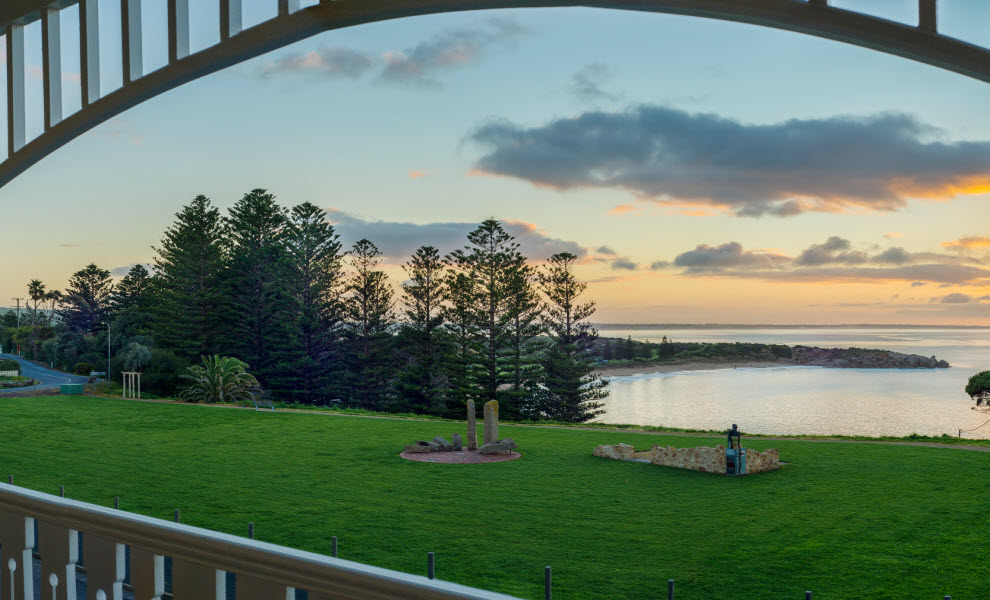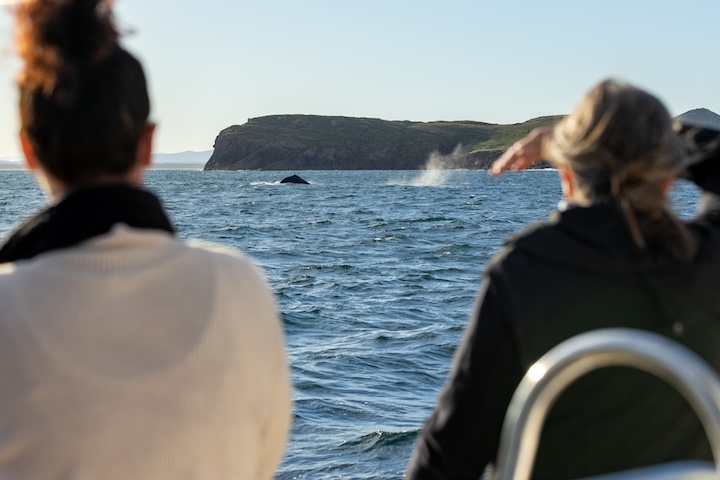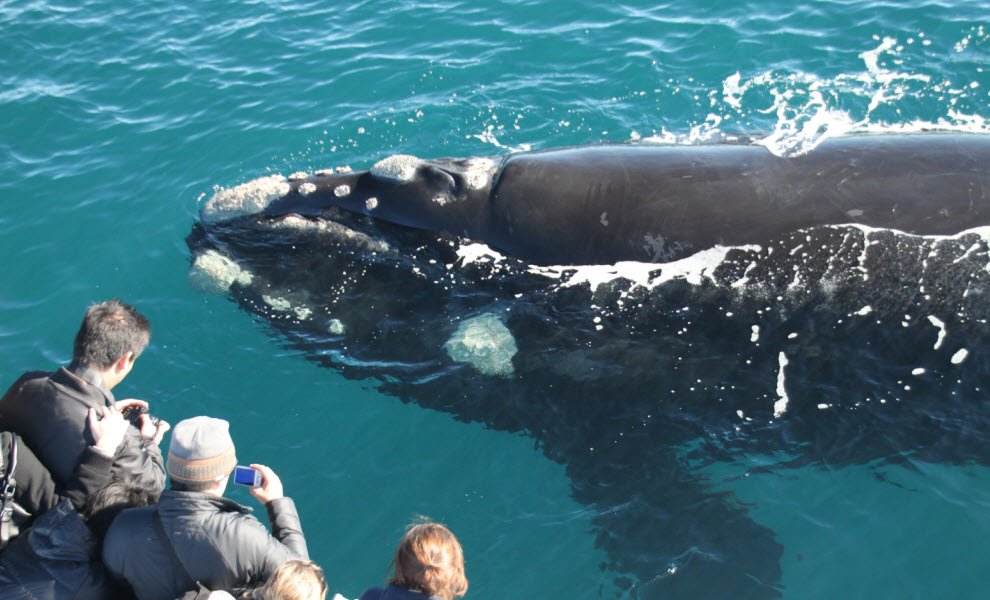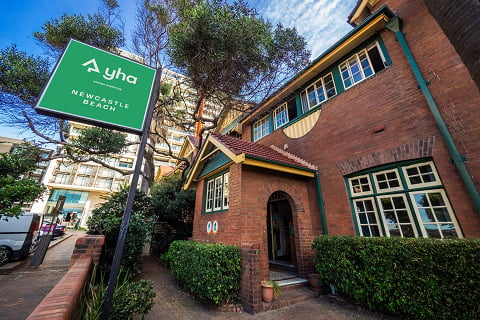The top whale watching spots in Australia
Sydney

Image: Whale Watching Sydney
More than 30,000 whales – mainly those acrobatic humpbacks but also the occasional southern right, minke, and blue whale – will migrate past Sydney’s rugged cliffs each season, the biggest mass migration in the world.
The true value of a Sydney whale watching cruise is those epic views of Sydney Harbour you'll be treated to before cruising out to sea for an unforgettable morning or afternoon spotting whales. Once bobbing on the open sea beyond Sydney Harbour, either by experience, vibrations or a difference in currents, the animals seem to know they're near a city and often linger a bit to show off. They certainly know you're there to see them, at the very least.
As you motor back between the heads, it's not uncommon to have dolphins skip alongside your vessel. Seeing the sun fading over the western horizon as you motor back towards the twinkling lights of Sydney at dusk is a particularly special experience, and we highly recommend it.
Stay: YHA Sydney Central | YHA Sydney Harbour
Byron Bay
Between May and November, Byron Bay’s coastline transforms into a natural viewing platform for one of the world’s greatest wildlife spectacles: the annual humpback whale migration. With Cape Byron being the most easterly point of mainland Australia, it's perfectly positioned for incredible sightings, often just beyond the breakers.
From the headland, whales breach, tail-slap and spout as they pass by, with regular appearances from dolphins and the occasional turtle below. The walk to Cape Byron Lighthouse – which guests at both YHA properties in Byron Bay can experience on organised sunset walks – leads to one of the most spectacular vantage points on the east coast, with sweeping views across the Pacific and a front-row seat to the whale migration.
There’s no need to go far: some of the best vantage points are just a short stroll from your stay. Time it right, and you’ll be watching whales silhouetted against a glowing sunset sky – one of those classic Byron moments you won’t forget.
Stay: YHA Byron Bay | YHA Cape Byron
Port Elliot

Lazy whale watchers, your prayers have been answered. No need for a tour. No need for a bushwalk. No need to even change out of your pyjamas if you can’t be bothered. The balcony at YHA Port Elliot boasts 180-degree views of Basham’s Beach, a sheltered bay an hour south of Adelaide, where a pod of Southern Right Whales raise their calves each winter. That means dawn-till-dusk whale-frolicking every day in July and August.
Whaling almost wiped southern rights off the face of the earth in the 1970s. Even the species’ name comes from the fact that their languid nature made them ‘right’ to hunt.
But these days, intrepid southern rights travel as close as 100m to the shore when they’re gliding between Victor Harbor, Port Elliot and Middleton along the dramatic Fleurieu Peninsula, and set up their nursery just 50m from the sand at Basham’s Beach, making it prime whale-watching territory.
Or you can see it all from the YHA balcony in your PJs. Up to you.
Stay: YHA Port Elliot
Newcastle

Newcastle’s rugged coastline delivers a front-row seat to the spectacle of migrating whales – no binoculars or boat required. Humpbacks can often be seen just offshore as they journey past the city’s headlands and beaches.
One of the best ways to spot them is along the Memorial Walk, a striking clifftop path linking Bar Beach to Strzelecki Lookout. With the ocean stretching endlessly to the horizon and steel sculptures marking Newcastle’s history, it’s a walk where nature and story intertwine.
Stay at YHA Newcastle Beach and you’re right at the edge of it all – close to coastal trails, lookout points, and spontaneous sightings from the shore.
Stay: YHA Newcastle Beach
Hervey Bay

Image: Tourism and Events Queensland
Hervey Bay is the final stop on the whales’ 10,000km journey north each winter, when they seek warmer waters to mate, give birth, raise their calves and just chill out. Hervey Bay is also your launch pad for the postcard-perfect K'gari (Fraser Island), which shelters the bay for humpbacks to rest up and raise their young before the long haul back to Antarctica.
What makes Hervey Bay so unique is the fact that unlike other whale watching hotspots on Australia's East Coast, the whales here aren't on the move. Choosing the bay's calm waters as a stop off to relax and play, they exhibit different behaviour to those in-transit, often approaching the boats and even putting on a bit of a show.
You only need to stroll around Hervey Bay to see what whales mean to the place. There’s the 14.8m wide, 22-tonne sculpture of ‘Nala’ the whale leaping out of the ground in the middle of town. There’s the nine-day festival each August to celebrate the annual migration. There’s the veritable flotilla of boats coming in and out of the aptly named Whale Bay Marina - the best way to see the humpbacks rolling, spy hopping, and breaching, as well as performing their rhythmic songs to an admiring audience.
Port Stephens

Image: Destination NSW
Port Stephens is home to 130 bottlenose dolphins all 12 months of the year – but when the big boys roll in during their annual journey up the East Coast in late May, the dolphins know it’s time to shuffle off centre stage.
“During the winter months they take on the role of supporting act for their bigger cousins,” says Bronny Starling from Imagine Cruises, an eco-friendly whale-watching tour operator with over a decade of sustainability certification under its belt.
“There’s nothing quite as spectacular as a 30-tonne animal lifting its entire body out of the water...To see them socialise, travel, and navigate their surroundings is quite special and to see the sheer size of these animals is quite humbling.”
And when you’re standing in a catamaran transfixed as a humpback breaches through the surface of the water then slaps its enormous body back into the sea, it’s hard to disagree. Port Stephens – a region of 26 sparkling beaches just two hours’ drive north of Sydney – will witness 25,000 whales pass their coast between now and November, a humpback population that’s growing almost as steadily as their number of followers.
To accommodate whale watchers, the council has opened a new walking path along the striking Noamunga Headland in Boat Harbour, while Tomaree Head and Barry Park in Fingal Bay both offer sweeping views of the Pacific.
Oh, and whales aren’t the only wildlife you’ll see in Port Stephens. There’s the resident dolphins, a rookery of albatross that come to feed during the cooler months, and a small colony of fur seals that sun themselves on Cabbage Tree Island at this time of year.
But the humpbacks leave you in no doubt about who are the stars of the show.
Albany

Image: Tammy Chapman/Tourism WA
There’s something in the water around Albany...literally. The spectacular port town – 400km from Perth on the south coast of Western Australia – is accustomed to placid humpbacks and southern right whales floating past between June and October.
But a pod of killer whales? That was always going to make a splash when marine scientists made the discovery in recent years, in Bremer Bay canyon east of Albany.
The rare congregation of orcas was found in a tiny, nutrient-rich patch of water that catches cold, salty currents from the Antarctic for six weeks each summer (February-April), luring up to 100 orca – as well as plenty of other marine life for dinner – to the biological hotspot 40km off the coast.
The seaside town is a former whaling port, but the hunters’ harpoons have long been traded for travellers’ long-lens cameras, and the old whaling station has been converted into a world-class museum.
It’s a scenic one-hour hike from the museum to Peak Hill, the highest point in the Torndirrup National Park, which offers panoramic views of the Southern Ocean as the whales seek shelter on their migration to and from the Antarctic.
But be warned, nutrient-rich salty water isn’t the only thing being blown north from Antarctica – remember to rug up to escape the wintry bite of the wind.
Whenever you find yourself along the coast of Australia, keep an eye out for these migrating aquatic beauties!








